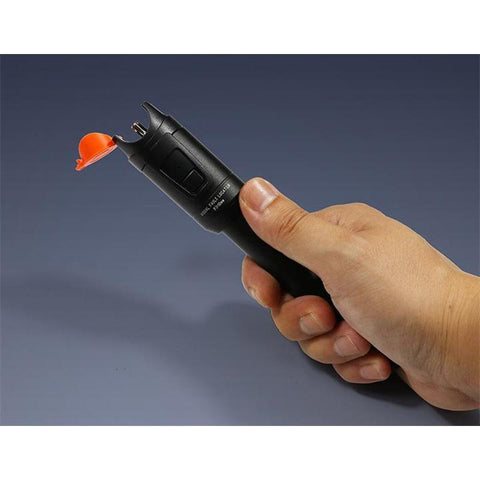VFL is now one of the most commonly used fiber optic testing devices to trace optical fibers, check fiber continuity and find faults such as breaks, bad splices and tight, sharp bends in fiber optic cable.
VFL, also called Visual Fault Locator, is a device which is able to locate the breakpoint, bending or cracking of the fiber glass. It can also locate the fault of OTDR dead zone and make fiber identification from one end to the other end. Designed with a FC,SC,ST universal adapter, this fiber fault locator is used without any other type of additional adapters ,it can locates fault up to 10km in fiber cable, with compact in size, light in weight, red laser output.
Working Principle:
A powerful visible light from a red diode laser is injected into the fiber, so not only fibers can be traced, but also high loss points can be made visible. Most applications center on short cables to connect to the fiber optic trunk cables, such as those used in premises cabling or telco central offices. The VFL works best on short cables, up to a few kilometers, thus, it covers the range where optical time-domain reflectometers (OTDRs) are not useful because of the dead zone of the OTDR.
Importance of Visual Fault Locator:
Fibre optic networks use an infrared light which the human eye cannot see. Additionally, the jumper, connector and optical fibre network is both integrated and complex, also making any fault locations challenging to identify. The visual fault locator swiftly and adeptly pinpoints issues that may otherwise take an impossible amount of time to find or may be invisible to the naked eye. The key benefit then to the visual fault locator is the timeliness and efficiency in identifying and thus addressing issues that this tool allows.
How to Use VFL?The steps to use a VFL are provided as following:
- Remove the plastic connector covers from both ends of the test fiber cable.
- Connect the fiber optic visual fault locator one end of the fiber. Press the tester button and observe that light emanates from the other end of the fiber. This gives a simple indication of the continuity of the fiber link.
- Repeat with several other fibers. Check for light that can be seen leaking from a faulty splice. This may illustrate an easy way of carrying out visual fault finding on bad splices or joints.
- Disconnect all equipment, put the plastic covers back on the connector ends and return everything to the state it was.
Application of Visual Fault Locator:
Visual fault locator is a kind of test equipment for testing, troubleshooting and measurement. The VFL is an ideal tool for locating a large number of defects that occur at connection and around fiber cabinets which are hidden in an OTDR “blind-spot” or “dead-zone”. Fiber breaks, faulty connector, sharp bends, bad splices and similar faults can be visually located by light radiated outside the fiber when the light is injected into a fiber. Visual fault locator can boost productivity in the field by providing fast detection, precise fault location, distance, loss, and ORL measurements.
Types of Visual Fault Locators
Visual fault locators generally include the pen type, handheld type and portable visual fiber fault locator.
Pen-Type Visual Fault Locator
Taking Pen-Type Visual Fault Locator 5mW as example, it is small in size and easy to be carried away.As showed in the picture below, with a pocket-size, can be carried anywhere easily.

Hand-held Visual Fault Locator
Hand-held VFL general has a larger size, and the weight is higher than pen-type VFL. As the following picture shows, is offered in a range of connector bulkheads styles,

Portable visual fiber fault locator:
Portable visual fiber fault locator is used to identify fiber and locate faults of single-mode or multi-mode fiber, it is a helpful assistant for finding fault in dead zone of OTDR, it is also a basic maintenance tool for fiber network, LAN, ATM fiber system and telecom network system. The appearance of a portable visual fiber fault locator is showed the following picture.

- Never look directly into the VFL’s output.
- Cover the VFL’s output with the dust cap when the VFL is not in use.
- Not recommended for use on dark colored or armored cables.

